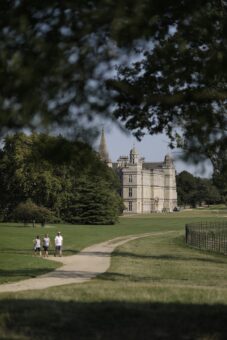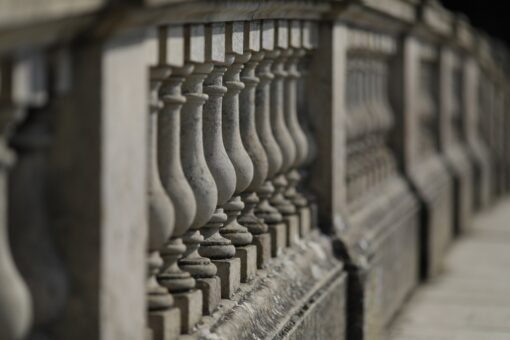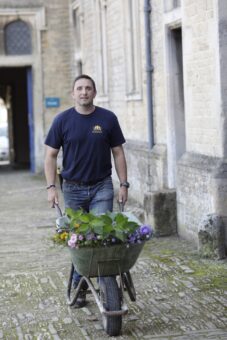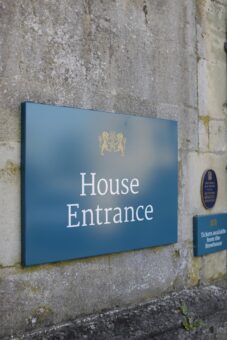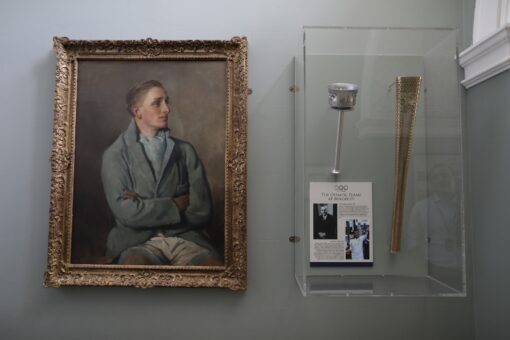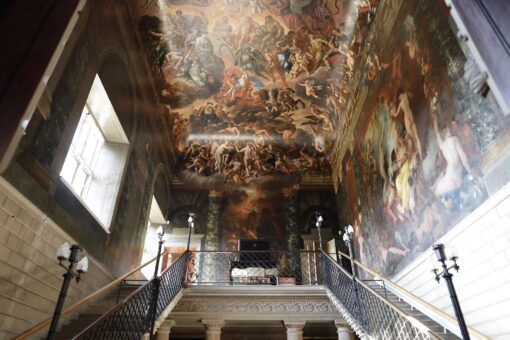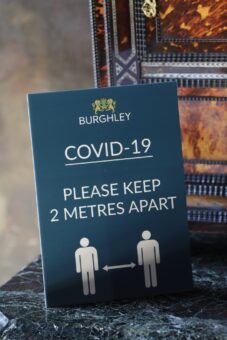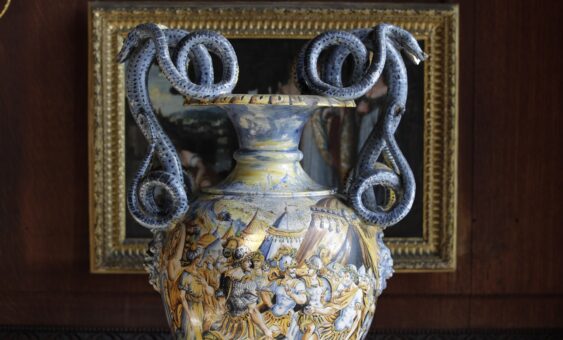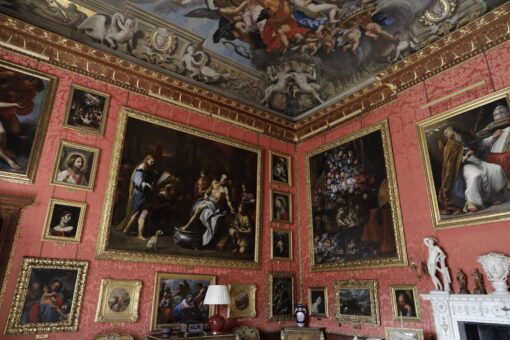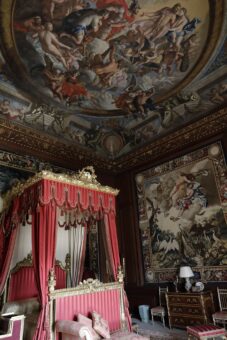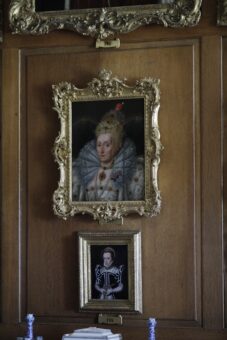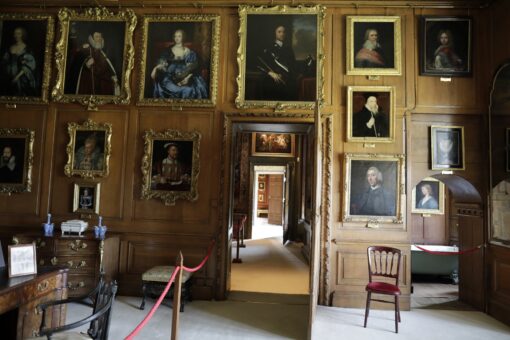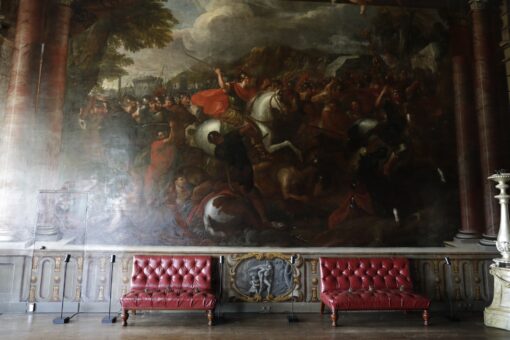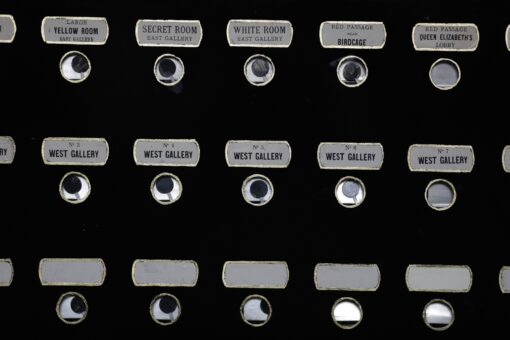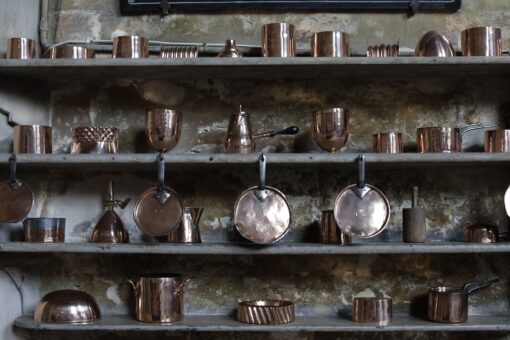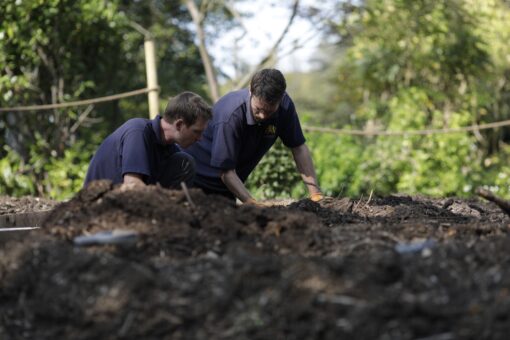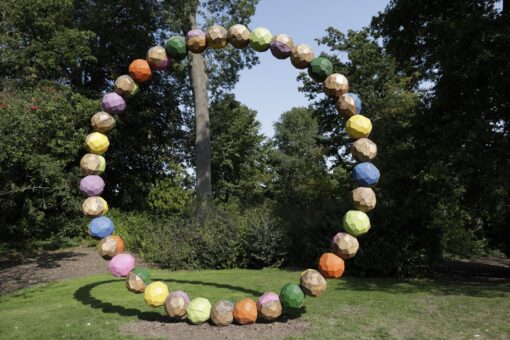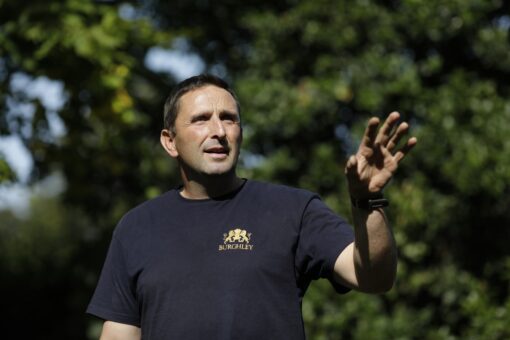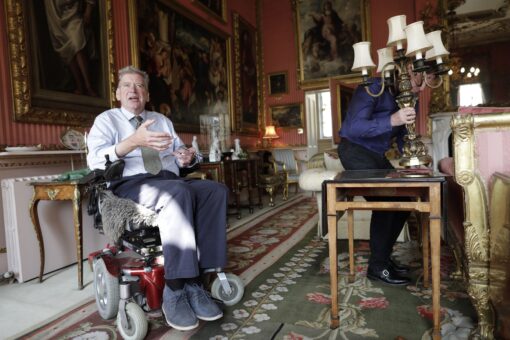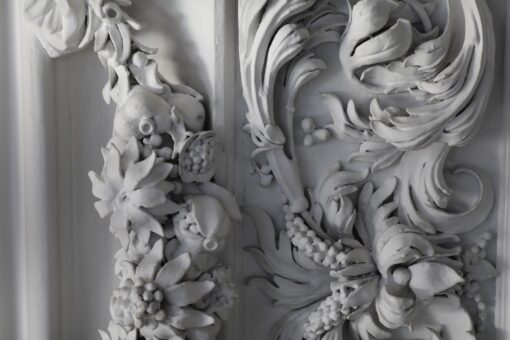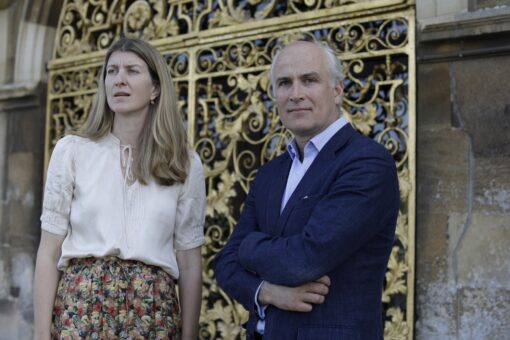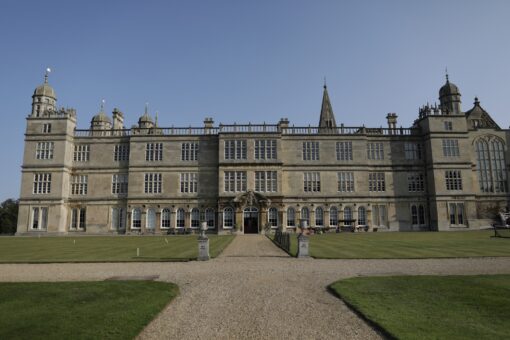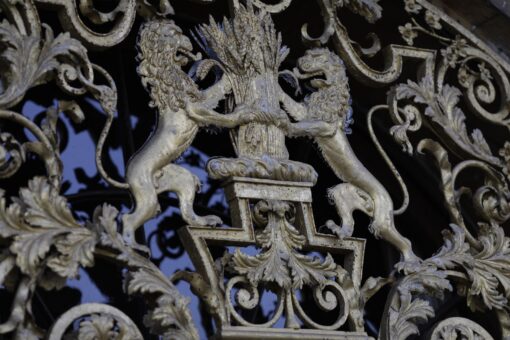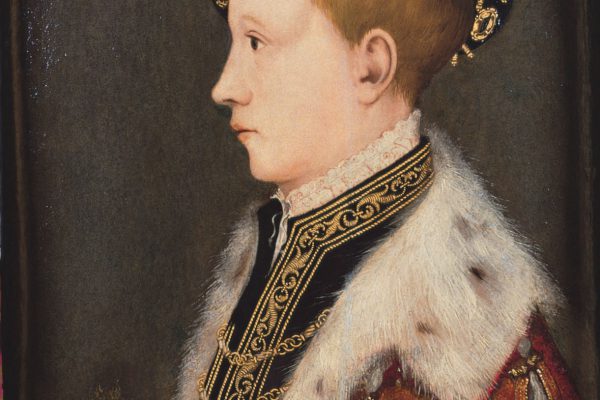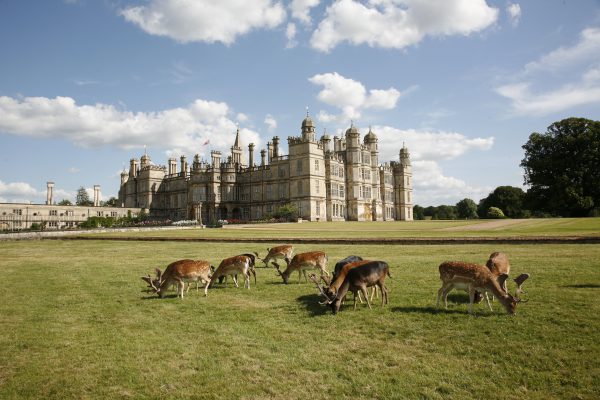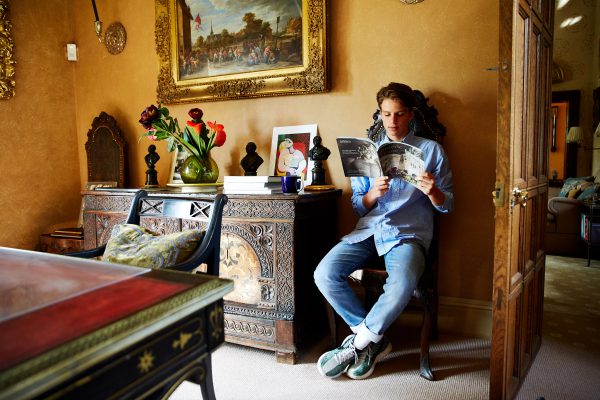All there is in Heaven and Hell: The Story of Burghley House
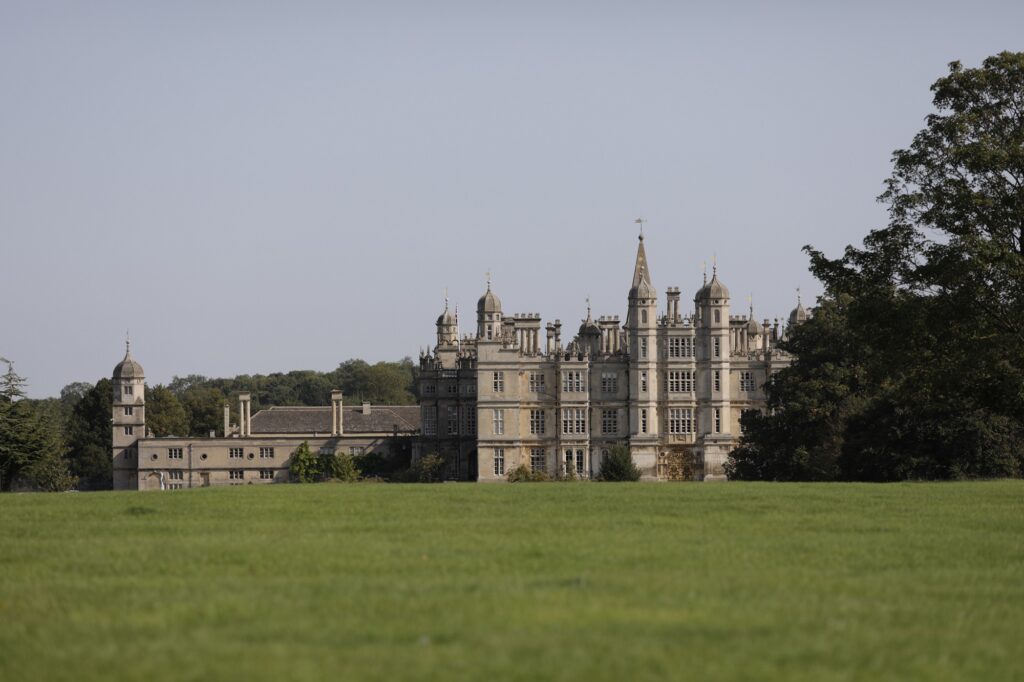
The park at Burghley is teaming with people when we arrive on a bright sunny day in September. Although the house, recently reopened after its enforced coronavirus closure, is having a regular day off, the park gate is never shut, pandemic or not. The rolling green space, studded with ancient oaks and carrying the flamboyant Elizabethan house on a knoll in its centre, like a crown on a great green cushion, has never been more popular. Individuals and groups of all ages are picnicking, walking, and exercising. The town of Stamford is just on the other side of the park wall and throughout lockdown this space provided a vital resource for the inhabitants’ wellbeing.
Permanent free access to this glorious landscape was one of the stipulations of the settlement of the 6th Marquess of Exeter, a 1928 Olympic gold medal winner, whose student sprint around the Great Court of Trinity College, Cambridge inspired a scene in Chariots of Fire, and who, as president of the IAAF, hung the medals round the necks of the athletes who gave the famous ‘Black Power’ salute at the 1968 Mexico City Olympics. He had been forced to sell off parts of Burghley’s extraordinary art collection (happily still largely intact, despite those disposals) to pay crippling death duties when he succeeded his father in 1956. Determined to keep the rest of the house and its contents together he put the estate into an independent charitable preservation trust in 1961.
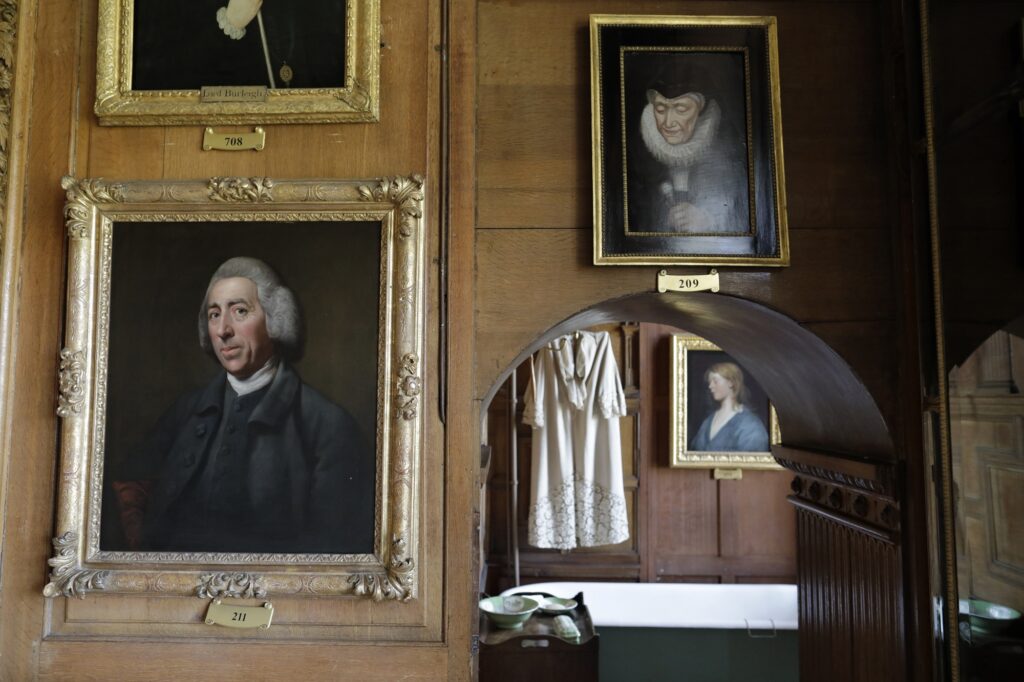
It’s a commonplace in the pages of this magazine to celebrate continued evolution as a strength of independently owned historic houses. But it would not be fair to say that places in the hands of charities or trusts don’t have a contemporary life. Burghley is both a treasure house of art and architecture preserved for the nation, and a family home. On both fronts it evolves with the times, as I discovered from its custodian, Miranda Rock.
The first Rock I meet is teenage son Cosmo, out walking Flapjack and Crumble, the family’s dog’s, at a brisk pace past the evidence of tennis and croquet matches still out on the lawn by the east front. House manager Miranda and her husband Orlando have lived here since 2007, when Miranda took over from her mother, Lady Victoria Leatham – the 6th Marquess’s daughter.
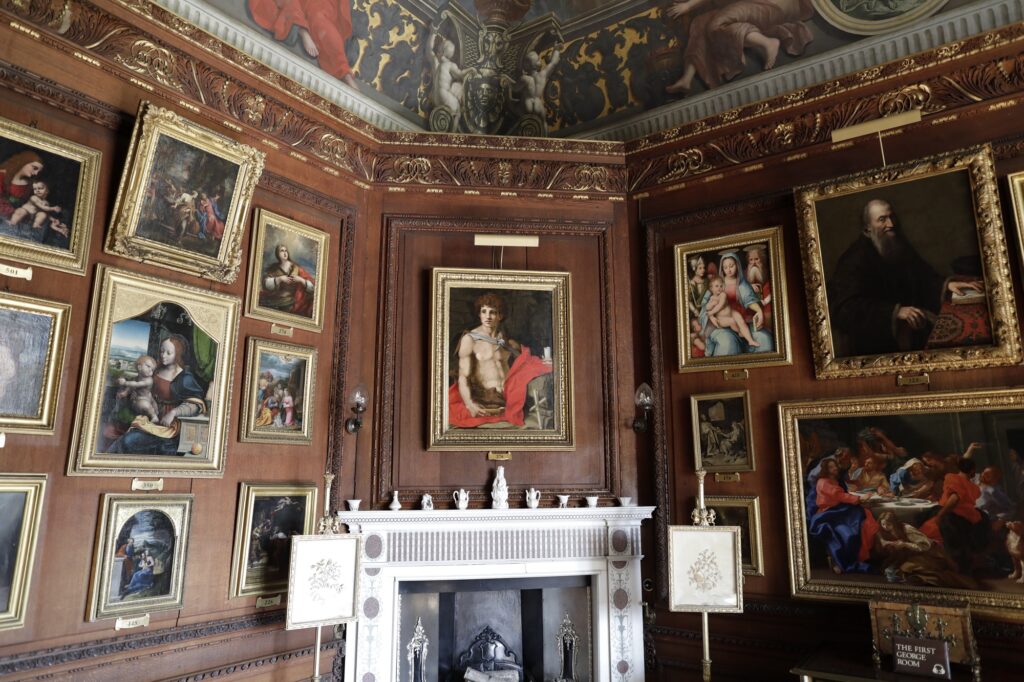
Lady Victoria undertook a gargantuan task of rediscovery and conservation during her 25-year tenure. The collection at Burghley has accumulated continually since the house was built by the Elizabethan courtier Sir William Cecil, 1st Baron Burghley, chief advisor to Elizabeth I for most of her reign, who was born exactly five hundred years ago, in 1520. Both Sir William’s sons – Thomas, 1st Earl of Exeter, and Robert, 1st Earl of Salisbury – were prominent political figures of the Tudor and Stuart period. But Robert outshone his younger brother and was progenitor of a political dynasty culminating in Lord Salisbury’s forming an administration as Prime Minister between 1895 and 1902. If their house, Hatfield, was home to the ‘political Cecils’, then Burghley was the showcase for the taste and patronage of the ‘artistic Cecils’.
Two incumbents in particular acquired the largest parts of today’s dazzling assemblage – the ‘Travelling Earl’, John, 5th Earl of Exeter, who lived in the second half of the seventeenth century, and Brownlow, 9th Earl, his Georgian descendant, who also spent much time on the continent a hundred years later. Besides paintings that would be the envy of many a national gallery – important Italian Old Masters, Flemish still lifes, portraits, and more – there are exquisite objects of every kind, from sculptures to clocks, porcelain to silver.
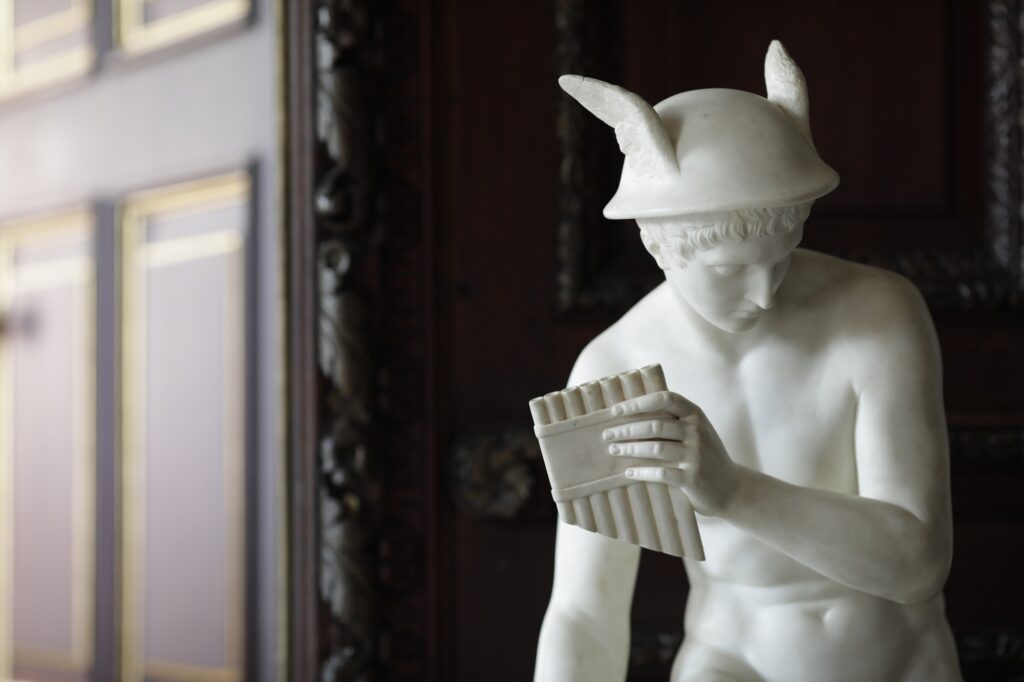
Although the external windows give the appearance of three principal storeys, in reality the state rooms of the first floor are double height. They form a circuit around the inner courtyard (though none but the chapel afford any view of it, designed as they are to face the parkland), and contain the bulk of the artworks that regular visitors see. But there are significant parts of the collection on the ground floor, where Miranda and her family live – especially much of the more ‘domestic’ furniture, and fragile items.
There are also modern pieces here. Miranda’s husband, Orlando, is chairman of the auction house Christie’s, so no stranger to the art world, antique and contemporary. There are important Japanese objects at Burghley, including the earliest kakiemon – Japanese porcelain – mentioned in European records, catalogued in the 1688 inventory of the 5th Earl (and including as a priceless pair of ‘wrestling boys’ which had been used as a doorstop until its significance was realised in the 1980s). Orlando and Miranda’s more recent acquisitions of ceramic art include clearly referential pieces such as a robed figure surrounded by an impossibly delicate-looking bouquet of flowers whose petals, on closer inspection, are revealed to be made of broken shards of much earlier china. These rooms are not regularly open to day visitors, but are frequently host to groups, art historians, and researchers. The family touch is ever-present, but even Cosmo’s impressive array of Star Wars Lego is carefully curated on an antique marble-topped table in one of the corridors that, unlike the procession of rooms above, open onto the courtyard.
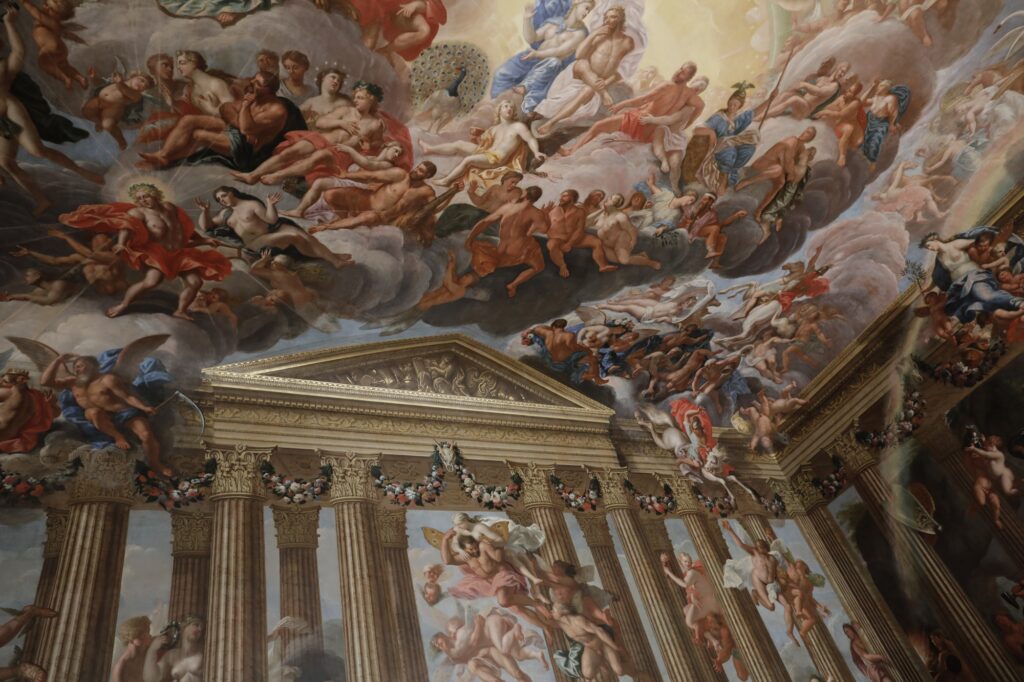
Originally an open loggia, enclosure of this arcade in the seventeenth century added some comfort to what must have originally been a cold and draughty house, only one room thick and made for showing off and impressing royalty more than for cosy living. Later creature comforts include the late twentieth-century installation of a downstairs loo in a hallway whose enormous gilded gates indicate that it was once the carriage entrance piercing the south front. Sympathetically camouflaged to look as if it has always been here, beneath the soaring Tudor Gothic vaults, it’s hard to imagine the annoyance, before its installation, of needing to go up two floors, to the attic storey in which the family still sleep.
In between those two domestic floors the procession of Baroque state chambers remains stiff and formal – as it would always have been – but is are an admirable gallery for the numerous oil paintings, which cover the walls of all but three rooms. Two of those – the ‘Heaven Room’ and the ‘Hell Staircase’ used to reach it – are named after the Antonio Verrio murals, executed in the 1690s, that cover their walls and ceilings; Olympian gods and goddesses enjoying a day by the sea, in the first; souls in torment being dragged into in the maw of a rather large cat, in the other. The works – frequently seen in film – are bright and vibrant, thanks to a recent restoration. Eagle-eyed visitors will notice a lady teetering on the brink of the inferno, high above the ‘Hell Staircase’, who appears to be naked apart from an incongruous pair of knee socks; her ‘clothing’ is in fact a last sample of the smoke and grime that formerly covered the entire wall, left to show contrast.
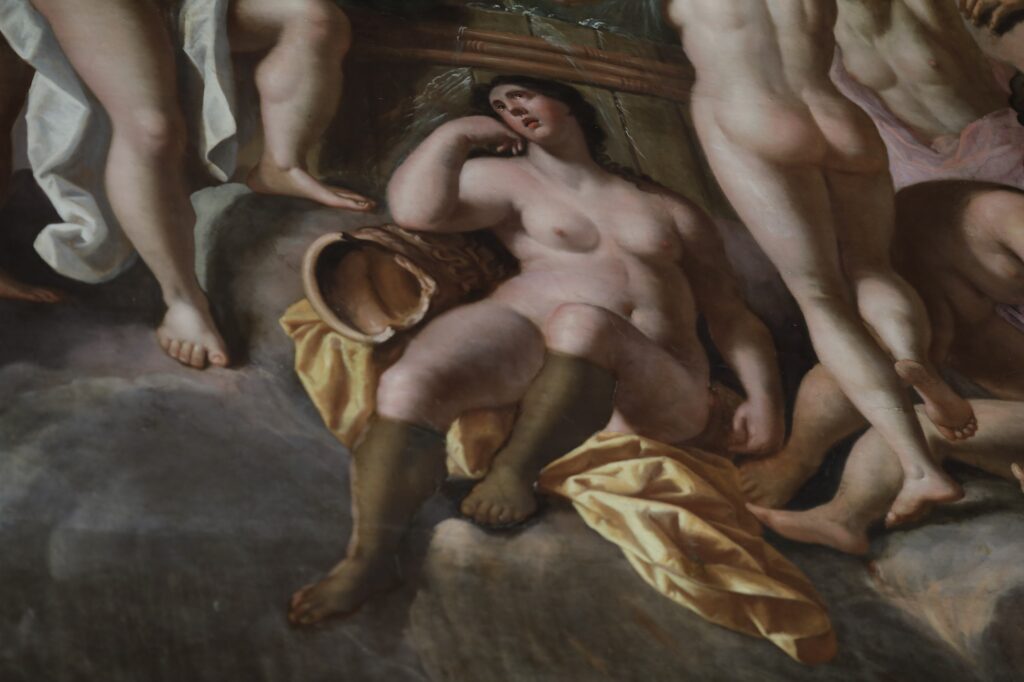
The Tudor Great Hall avoided the 5th Earl’s classicisation, perhaps because it was simply too big – soaring from the ground to the roofline, with two full-length windows and one mighty fireplace, which one wonders could have been enough even then to really warm the place for state banquets, such as that for Queen Victoria and Prince Albert of which a drawing can be seen in the room today. Another survivor of the Tudor house is the similarly lofty kitchen, now merely a museum piece. Both sit on the east side of the house, and tail off into a wing extending to the north (once matched by a twin that would have formed a symmetrical ‘E’, but was demolished by the 9th Earl to allow a better view of the parkland) and auxiliary buildings – former stables and barns turned in offices, gardeners’ sheds, and some small business units let to craftsmen.
It’s a tenant of one such workshop, Anthony Beech, whom we meet, along with long-serving collection curator John Culverhouse, to examine for ourselves some of the pieces of furniture in the family apartments. The two have made a recent discovery on the underside of an eighteenth-century marquetry side table from the workshop of a local cabinet maker. It’s an incredibly rare trade label (putting what amounts to advertising on an expensive bespoke commission being quite the cheek). It reads:
Henry Tatam
(from Mr. Cobb’s, London)
Cabinet Maker, Upholder & Appraiser
The Corner of the Butcher Row, Stamford
Lincolnshire
Makes and Sells every Article in the
Upholstery and Cabinet Business
So Noblemen and Gentlemen may have their Fur-
niture made in the French mode or any
Other Taste, Variagated with Different
Kinds of Wood, as well as Executed as in
London, and on as Reasonable Terms
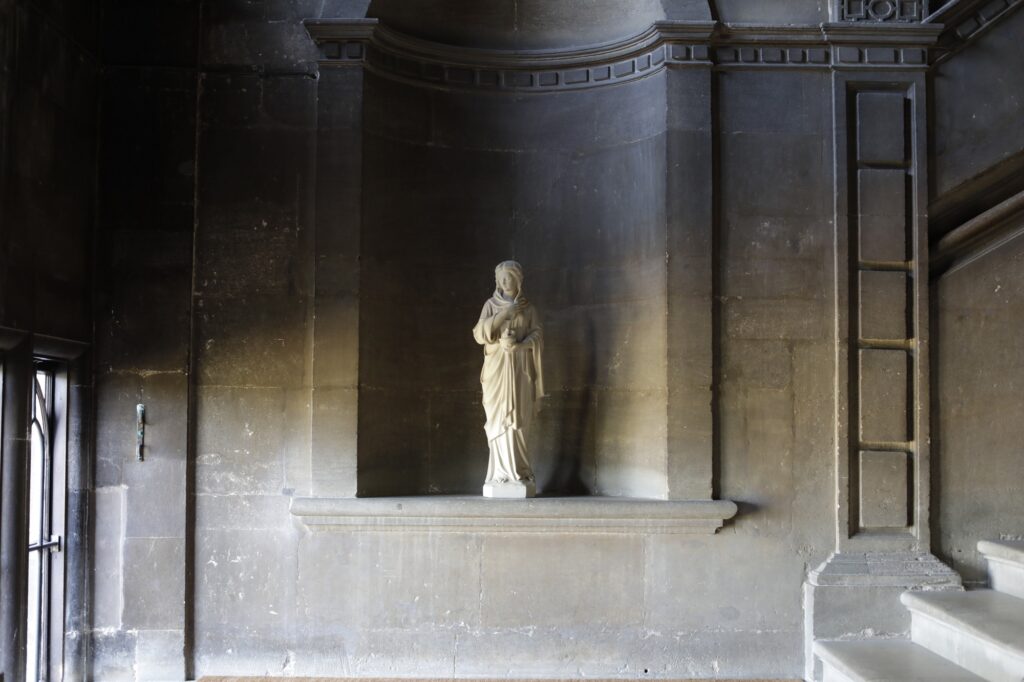
We’re here to discuss some of the finest elements in the collection, but the really is simply too much to choose from (though can make your own picks from the comfort of your armchair thanks to comprehensive online displays at collections.burghley.co.uk). It’s more engaging to follow the threads of the personal stories these pieces embody, and as we look at objects chosen almost at random in the drawing room, the characters of their collectors come through.
The 5th Earl met with the finest artists of the day on his travels and bought pictures directly from the studios of Old Masters, before they were ‘old’. There is no doubt he was a man of taste and set the tone for the collection his descendants inherited.
By contrast, the 9th Earl, whose tastes included gilding whatever could be gilded (including a number of ceilings) made purchases in a less discriminating manner, as if driven more by the acquisition of status than of beauty. ‘He bought one or two clangers,’ says John, ‘but then I suppose if you’re in Italy and a local promises you something is the real deal, you can’t easily check up on their claims.’ As a result, John tells us, the provenance and quality of the items he added can be a little more hit and miss.
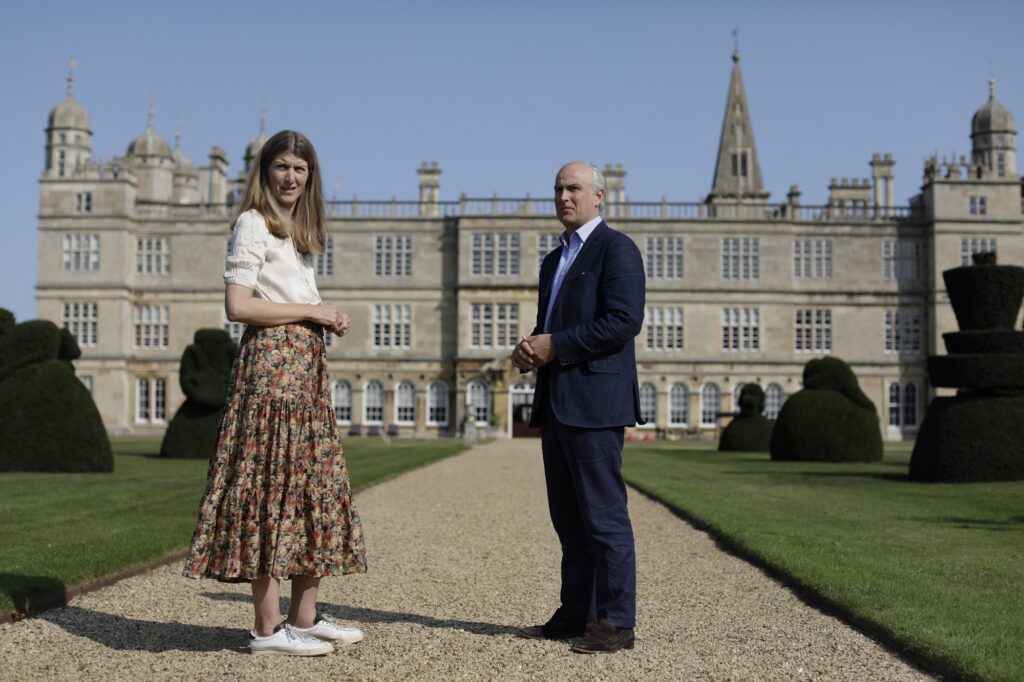
Rifling through the draws of a seventeenth-century Flemish cabinet of tortoiseshell and ebony, painted inside with scenes from Greek mythology (known as the ‘Rubens Cabinet’, but certainly not by Rubens, John tells me), we continue to encounter the family. To everyone’s surprise, it’s full of press cuttings from the 1920s of Lord Burghley’s (later the 6th Marquess) race results and birthday parties. Upstairs, too, the faces of the modern age are juxtaposed with the grandees of the past – kings and queens hang alongside the 9th Earl and Michael, the 8th and current marquess, who lives in Canada.
His father, Martin, who emigrated in 1930, was the younger brother of Miranda’s grandfather, David, who had only daughters. He’s a great supporter of the work of his uncle’s charitable trust and sits on the board, but is happy to be involved from across an ocean. It fell to David’s daughter by his second marriage, and Miranda’s mother, Lady Victoria, to take on the mantle of living in the house. She devoted her whole life to unpacking – in some cases literally as well as figuratively – the often-forgotten treasures of the vast family collection. Items were conserved and catalogued, pictures rehung, curtains restored, the roof re-leaded; her efforts made for compelling television, and she became a favourite personality of the 1980s.
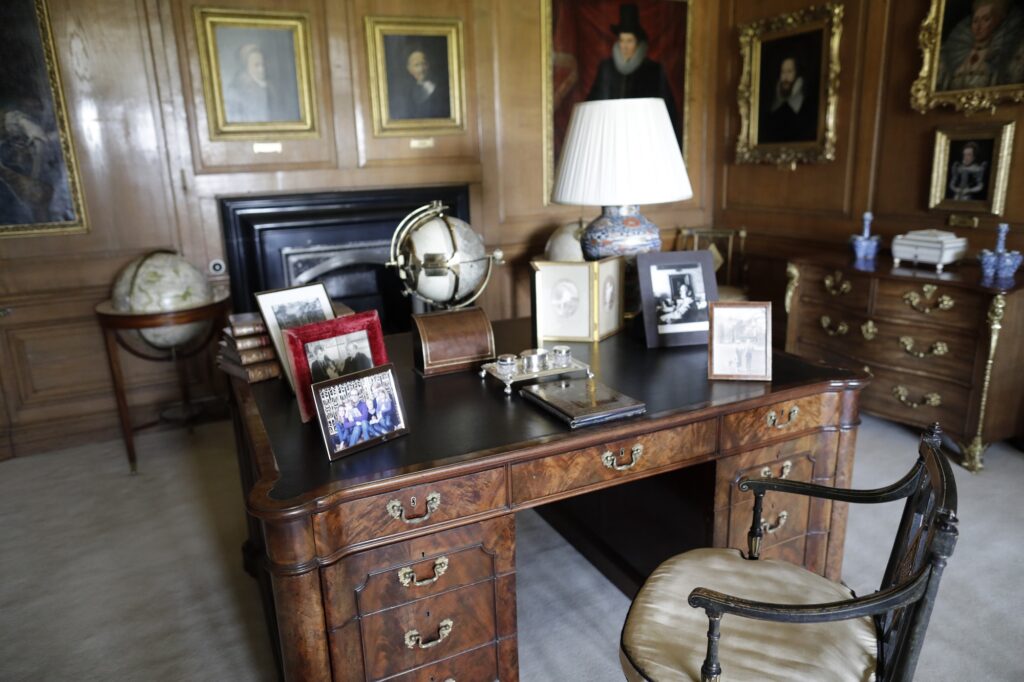
The vigour and thoroughness with which she did so means Miranda’s task is different. ‘The days of finding priceless pieces that had been hidden for centuries in draws and tea chests are over,’ she tells me, in a tone that suggests a mixture of regret and relief. Instead the emphasis is on interpretation and the visitor experience. ‘We may have been a bit earnest in the past, and we want to do more to draw out the stories of the people, because that’s what’s so interesting.’
Miranda co-manages the trust with an estate director who oversees its wider assets – a significant endowment of land and houses providing income to support the house and collection. The last few years have seen a rebrand that has aimed to bring the running of the two elements closer together, and the creation, for the first time, of a masterplan. There will be greater investment in the parkland and in family facilities such as play areas – not so much a change in emphasis away from the academic and art-historical priorities of the past, but an addition to them, recognising that so much of the work of organising and cataloguing has been completed; that remarkable achievement has in turn thrown up new needs.
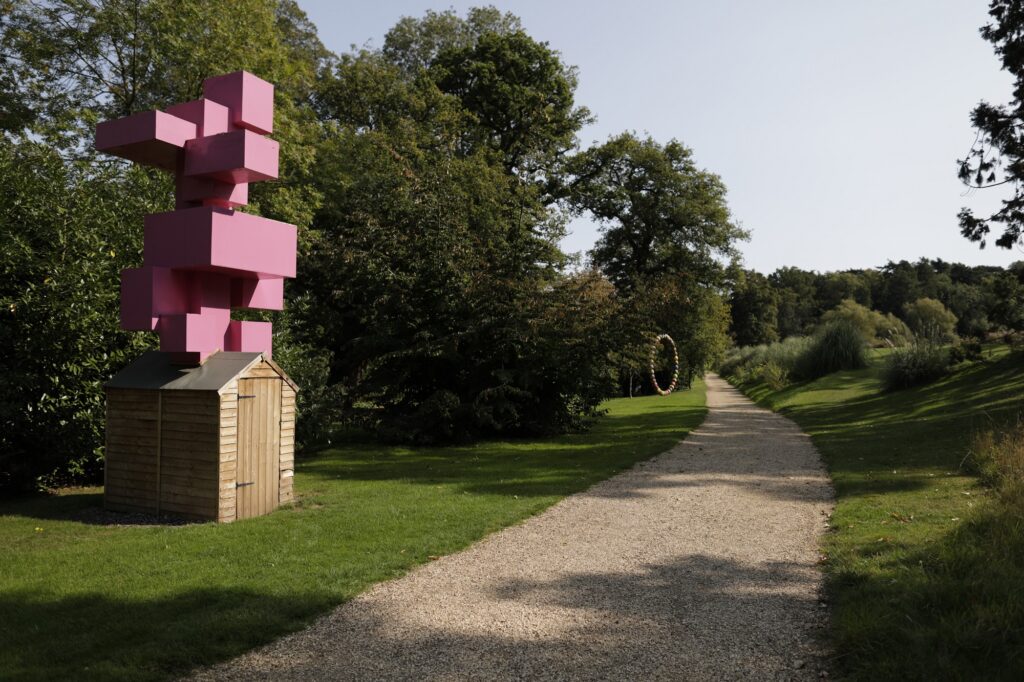
The gardens, too, are a new focus of effort. Joe Whitehead, the Head Gardener, has been in his post for three years now, though he’s no newcomer – his first job was at Burghley, a number of years ago (I’m too polite to ask how many). ‘People used to come outside after looking round the house and ask, “Where are the gardens?”’ he tells me. ‘They weren’t something we were known for.’ That’s all changing. In the past few years, a sculpture garden, a ‘garden of surprises’ and the introduction of thirty thousand new plants have made the outside as much a part of the visitor experience as the inside. We find Joe and his team, which includes local volunteers, working away at clearing overgrown, oppressive laurels and preparing a new walk through carefully selected North American species chosen to match two old Canadian specimen trees on the site. On top of his current projects, there remains a thirty-acre walled kitchen plot, some distance from the house, awaiting a grand design for restoration and reuse.
The emphasis, though, remains on the long-term safeguarding of the house, its contents, and, increasingly, the natural environment of the estate; a study has recently been undertaken, for example, to better understand and mitigate the impact of soil compaction from special events on the flora of the parkland. Public access and education are at the heart of the charity’s objects, but although visitor numbers have risen hugely over the past few years, footfall is not the main aim; as Miranda says, ‘We want people to come and enjoy themselves and get something out of it, not just to push more and more people through, which can ruin it for everyone.’
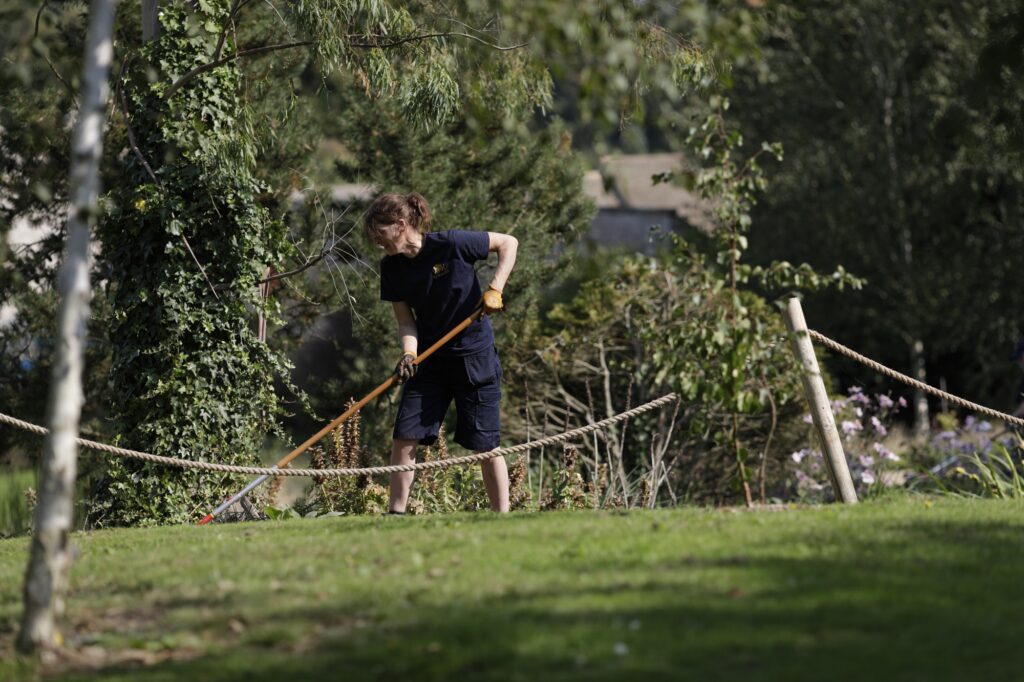
Long-term planning is, of course, the responsibility of the trustees, though there is a clear desire to keep Burghley’s special atmosphere as a lived-in home. Did Miranda ever think as a child that she would step into her mother’s shoes? ‘No, as a child you can’t imagine anything changing, and it was just home,’ she says. ‘There’s no doubt growing up here amongst beautiful things influenced my decision to study art history, and that, along with Orlando’s career and the understanding that brings, no doubt helped us make the big decision to leave London and come here when my parents left. Their departure was a clean break – there is no Dower House here – and I think that makes it easier for everyone. They live a house of their own half an hour away.’
And what about the question of her eventual successor? Do her own children have the desire to take it on? ‘You may not understand as a child what it us to live and work in what is effectively a museum, but it gives you an insight. And I’m happy that it hasn’t put any of my children off history – they’re fairly interested. But when the time comes the trustees will want to find the right person for the moment, for what the estate needs – and I don’t for a minute assume that will be any of my children. I have a very big family.’
This article was written for Historic House magazine in 2020, the official magazine for Historic Houses members. Read more articles like this by becoming a member of Historic Houses.
With thanks to Burghley House. Photographs by Layton Thompson, copyright Historic Houses 2020.
Burghley House is free to visit for members of Historic Houses.
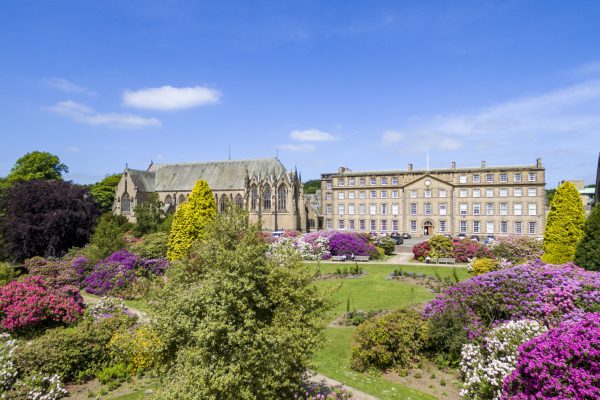
Rome Is Where the Heart Is: The Story of Ushaw
In this article for Historic House magazine, author Elena Curti discovered an extraordinary Roman Catholic institution in County Durham; Ushaw Historic House, Chapels and Gardens.

